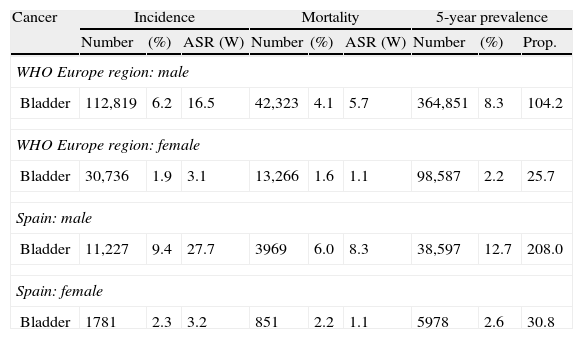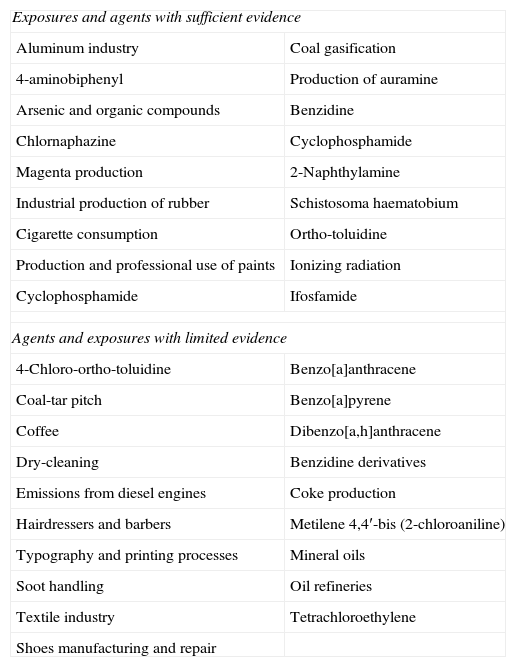Bladder carcinoma (BC) is the fourth most common type of cancer in males from Western countries, with primary prevention an important healthcare challenge. We review the associated constitutional and occupational risk factors (RF), with greater or lesser scientific evidence, in the etiology of BC.
Material and methodsLiterature review of the last 25 years of the constitutional and occupational RF associated with BC, conducted on MedLine, CancerLit, Science Citation Index and Embase. The search profiles were Risk factors/Genetic factors/Genetic polymorphisms/Epidemiology/Occupational factors and Bladder cancer.
ResultsThe main RF were (a) age and gender (diagnosed at age 65 and over, with a 4:1 ratio of males to females); (b) race, ethnicity and geographic location (predominantly in Caucasians and in Southern European countries); (c) genetic (N-acetyltransferase-2 and glutathione s-transferase M1 gene mutations, which significantly increase the risk for BC); (d) occupational, which represent 5–10% of BC RF; and (f) occupations with high BC risk, such as aluminum production, the manufacture of dyes, paints and colourings, the rubber industry and the extraction and industrial use of fossil fuels.
ConclusionsBC is the end result of the variable combination of constitutional and environmental RF, the majority of which are unknown. The most significant constitutional RF are related to age, gender, race, ethnicity geographic location and genetic polymorphisms. The main occupational RF are those related to aromatic amines and polycyclic aromatic hydrocarbons.
En los países occidentales el carcinoma vesical (CV) es el 4.° cáncer más frecuente en varones, siendo la prevención primaria un reto sanitario importante. Se revisan los factores de riesgo (FR) constitucionales y ocupacionales implicados, con mayor o menor evidencia científica, en la etiopatogenia del CV.
Material y métodosRevisión bibliográfica de los últimos 25 años de los FR constitucionales y ocupacionales asociados al CP, obtenida de MedLine, CancerLit, Science Citation Index y Embase. Los perfiles de búsqueda han sido Risk factors/Genetic factors/Genetic polymorphisms/Epidemiology/Occupational factors y Bladder cancer.
ResultadosLos principales FR son: a) edad y sexo (se diagnostica en mayores de 65 años con una relación hombre/mujer de 4/1); b) étnico-raciales y geográficos (predominio en caucásicos y los países del Sur de Europa); c) genéticos (las mutaciones del gen N-acetil-transferasa 2 y el Glutation-S-transferasa-M1, incrementan significativamente el riesgo de CV); d) los FR ocupacionales representan el 5–10%; y f) las profesiones con mayores riesgos de CV son la producción de aluminio, manufactura de tintes, pinturas y colorantes, industria del caucho y la extracción y usos industriales de combustibles fósiles.
ConclusionesEl CV es el resultado final de la combinación variable de los FR constitucionales y ambientales. Desconocemos la mayoría de FR implicados en los CV. Los FR constitucionales más decisivos son la edad y el sexo, los étnico-raciales-geográficos y los polimorfismos genéticos. Los principales FR ocupacionales corresponden a exposiciones a aminas aromáticas e hidrocarburos policíclicos aromáticos.












